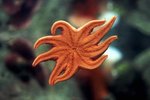
The word flipper usually describes the more fleshy appendages of marine mammals such as dolphins and whales, though it applies to sea turtles and even penguins as well. However, though flipper is a synonym for fin, it doesn't usually work the other way round. Not many people say flipper when speaking of fish. In everyday parlance, fish have fins and that's that -- though people do tend to use both words interchangeably when speaking of other marine animals. In the long run, it comes down to little more than semantics and convention.
Location, Location
Since fins and flippers are essentially the same thing, the difference between a dorsal fin and a flipper becomes a matter of location and function. The word dorsum -- from which dorsal derives -- is Latin for back or ridge, therefore the dorsal fin is located on the back of an animal. Flipper is the vernacular term for the pectoral fin of fish and certain marine mammals. It corresponds to the arm and hand of terrestrial animals, although technically, pectoral derives from pectoralis -- which actually means breast or chest -- and is a bit of a misnomer anatomically.
Keeping An Even Keel
The dorsal fin is one of the so-called unpaired fins because it follows the midline down the body -- in this case, along the back. While there is usually only one, some species will have two or three dorsal fins. However, each additional fin follows in line, one immediately behind another, and is usually designated by number, for example, first dorsal fin, second dorsal fin, and so on; or as spiny or soft dorsal fins, with the latter nearest the tail. The caudal, or tail fin, and the anal fin are the other unpaired fins. All unpaired fins work in a vertical plane to stabilize the animal's body and hold it upright as it swims through the water. The dorsal fin acts as a kind of keel to keep the streamlined, essentially torpedo-shaped, animals from spinning around as they move. Along with the anal fin, it may also serve to help move the animal forward by undulating.
Paired Pectorals
Whether you call them fins or flippers, those paired pectoral appendages serve to propel the animal through the water in the same way a human swimmer uses his arms. By tilting the flippers/fins up or down and by moving them forward or back, the animal can control its movement side-to-side, forward and backward. In most ways, these actions are analogous to the way humans control a boat with paddles. A major difference is that with only one paddle a human paddler can still control the boat by alternating paddles, but with only one pectoral fin, a fish would have difficulty not spinning in circles -- thus the biological necessity for paired fins.
The Evolution of Fins and Flippers
If you look at pectoral flippers of marine mammals under X-ray, you see an amazing likeness to the bones of the human arm and hands. This is an example of homologous structures between different species and reinforces the fact that we share similar origins. Homologous structures are those which have the same origin but different, if sometimes only slightly different, functions. Comparisons between marine mammal dorsal fins and the dorsal fins of fish -- especially cartilaginous fish like sharks, which have no bones, are a bit different. In that case, the structures are analogous, meaning they serve the same function, but evolved from different origins. This is a case where form clearly followed function, in which nature provided each animal a similar way to deal with the need for a keel.
References
- Dolphin Communication Project: Know A Dolphin's Body Parts
- EARTH: Background Information: Observing Deeply
- Harvard Gazette: How Fish Swim
- Hillpark Departments of Science: Homologous and Analogous, Vestigial and Competition
- Understanding Evolution: Homologies And Analogies
- Understanding Evolution: Analogy; Jaws Versus Flipper
Photo Credits
-
Comstock Images/Stockbyte/Getty Images




